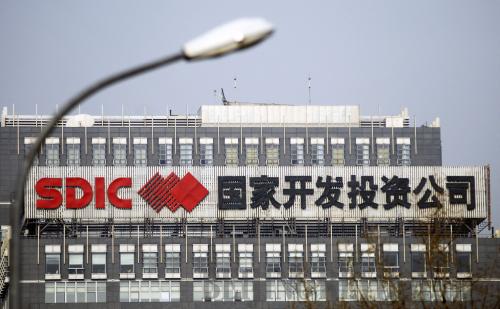|
 |
|
STATE-OWNED MAGNATE: The State Development & Investment Corp. stands in Beijing Financial Street (CFP) |
The State-owned Assets Supervision and Administration Commission of the State Council (SASAC) recently launched a new round of pilot reforms, designed to develop new state-owned asset management models in terms of strengthening asset management, promoting mixed ownership, improving corporate governance structure, and intensifying disciplinary inspection of corporate executives.
According to the reform plan, the State Development & Investment Corp. and China National Cereals, Oils and Foodstuffs Corp. (COFCO) will set up state-owned asset investment companies; the China National Pharmaceutical Group Corp. (Sinopharm) and China National Building Materials Group Corp. (CNBM) will diversify stakeholders by introducing mixed ownership; and the Xinxing Cathay International Group, China Energy Conservation and Environmental Protection Group (CECEP), Sinopharm and CNBM will practice new systems of executive selection and recruitment, performance evaluation and salary management. Aside from that, disciplinary inspection will be sent to another two or three state-owned enterprises (SOEs).
To keep the pilot reforms in check, the SASAC has tasked its enterprise reform bureau, property management bureau, enterprise reorganization bureau and discipline inspection commission with organizing four special teams to supervise the proceedings.
"The pilot reforms are primarily devoted to strengthening the supervision system for state-owned assets," said Peng Huagang, spokesman of the SASAC. For one thing, the role of the SASAC should be transformed from a manager to a stakeholder in SOEs; for another, the efficiency of the operation of state-owned capital should be enhanced by adjusting and optimizing investment orientation, making sure that these state-owned asset investment companies can meet national strategic targets.
A fresh start
The integration of the government with enterprises has allowed SOEs to gain the upper hand in acquiring resources, which has exerted a strong crowding-out effect on other competitors and undermined the efficiency of resource allocation. According to the 2014 Fortune Global 500 list, the three Chinese companies that nudged into the top 10 are all centrally administered SOEs. Moreover, the list of the top 500 Chinese enterprises published by the Fortune China website shows two thirds of the 500 companies are SOEs.
Amidst an economic transformation, the improvement of productivity is paramount. At present, SOEs still maintain a monopoly in many sectors by virtue of their government background. With fewer operating pressures, they are inadequately powered to make progress in technological research and development, cost control and industrial upgrading. In addition, the absence of an incentive mechanism goes against the target of enhancing efficiency.
To stimulate the vitality of the economy and enhance the productivity of SOEs, new reforms should therefore be initiated. Since it's not easy to ensure that reform yields positive results across a nation of China's size, the most secure approach may be first practicing it within a certain area or enterprise and then promoting it on a larger scale.
"It's a great opportunity for enterprises participating in the pilot reforms to surmount the interwoven problems SOEs confront through practice. In this way, detours and risks can be effectively avoided," said Peng.
He also noted that lessons learned from these pilot reforms will be conducive to the expansion of these measures and mechanisms. "Since enterprises are the subject of reform, the momentum of reform should also come from enterprises. In fact, many central SOEs have shown a strong desire to act as the first subjects," said Peng.
The move marks another step toward the full implementation of the SOE reform determined at the Third Plenary Session of 18th CPC Central Committee, and ensures that the government maintains absolute control of strategically important central SOEs. By first carrying out experiments in certain enterprises, the SASAC will minimize risks related to the reform's implementation, according to Moody's Investors Services.
Financial commentator Zhou Junsheng said that the different reform measures taken by the SASAC are tailored to enterprises inhabiting different market positions in the national economy. Intensified investment of state-owned assets can ensure the normal operation of some industries affecting national security and people's immediate benefits; the establishment of mixed ownership will help build a market where different market participants compete on a fair basis; more corporate management autonomy will give more space for state-owned assets to expand in the market; and strengthening the supervision of SOEs can effectively uproot corruption.
"In the process, the SASAC will ensure that top-level design and pilot reforms, marketization and government guidance, courageous exploration and defending the bottom line, and comprehensive progress and breakthrough at key points can all go hand in hand," Peng held.
| 